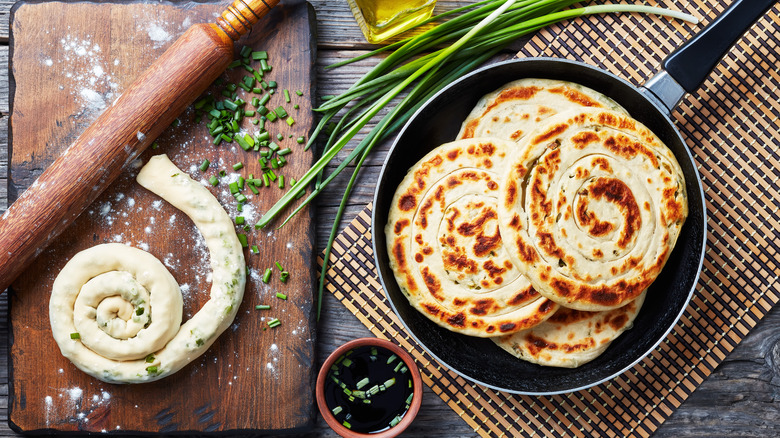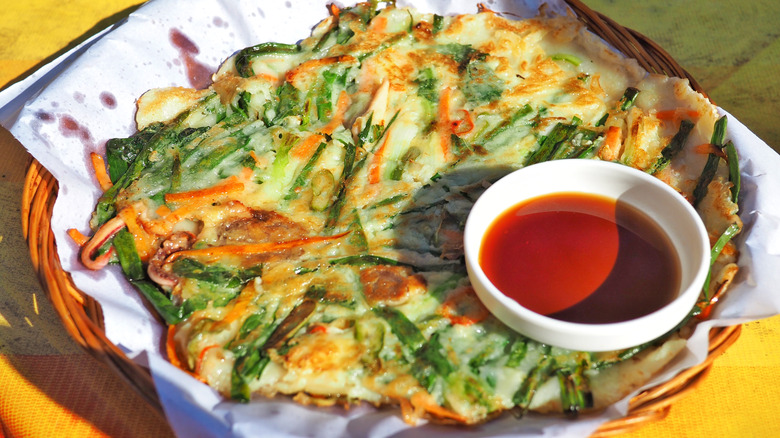Chinese Scallion Pancake Vs. Korean: What's The Difference?
Although they go by the same name, Chinese scallion pancakes and Korean scallion pancakes are actually quite different. If you've ever ordered a scallion pancake at a Chinese restaurant, you would know that it's like a dense, flat croissant (via Omnivore's Cookbook). These flaky pancakes have layers that unravel in a pleasing ribbon shape, which makes them the perfect vehicle for soaking up saucy stir-fries or enjoying them on their own for a satisfying appetizer.
Korean scallion pancakes or pajeon, on the other hand, look and taste more like pancakes as we know them in the U.S. — except they're not topped off with syrup (via Maangchi). They're made with a runny batter and fried in a hot skillet with oil, resulting in a crisp pancake that is soft on the inside. According to MasterClass, they are often served as an appetizer alongside dipping sauces and Korean rice wine.
Both pancakes may have a base of flour and scallions, but they have very different ratios and cooking methods, so let's take a closer look at the differences between these two savory pancakes.
What are Chinese scallion pancakes?
If you've ever had the Indian-style flatbread roti canai, you'd think that the Chinese scallion pancake is its long-lost sister. Both of these savory Asian pancakes have a spiraled dough that is flattened and pan-fried. Chinese scallion pancakes start off with a low-moisture dough composed of all-purpose flour, salt, and water, per China Sichuan Food. The pancake dough is made with both hot and cold water because the hot water initially softens the dough and creates a homogenous paste, while the cold toughens the dough and makes it firm. This dough-making process is probably the most important part of the recipe since it creates an irresistibly chewy and flaky texture.
The dough is rolled out paper thin and brushed with oil, Chinese-five spice, and chopped scallions (only the green parts). Once you've laid out the toppings, you roll up the dough into a tight cylinder and coil it into a spiral. The Chinese scallion pancake is like roti and croissants for this very reason: The thin layers of dough alternate with layers of oil, creating a flaky yet chewy bread.
The Chinese five spice powder adds a spicy and bitter flavor to the dough with its combination of cinnamon, cloves, fennel seeds, Sichuan peppercorns, and star anise (via Feasting at Home). Then, the finely diced scallion greens balance the flavor of the dough with their sweet, oniony flavor.
What are Korean scallion pancakes and how are they different?
You can find Korean scallion pancakes at almost every Korean BBQ restaurant. The Korean scallion pancake or pajeon closely resembles a fritter where the batter is more of a supporting role to the star of the show, the scallions. My Korean Kitchen makes pajeon with a watery batter of all-purpose flour, corn starch, and ice water. Ice water is a crucial element in making the batter crispier because the cold temperature prevents oil from seeping into the pancake while it's fried, per What to Cook Today.
Once the batter is complete, the whole scallions are placed side by side on the oiled pan. Maangchi notes that it is common for Korean scallion pancakes to contain seafood, so this is the time to add shrimp, mussels, or squid. Then, a small ladle of batter is poured evenly across the scallions to glue them together. The finished product is something between a fritter and vegetable tempura — the sweet and juicy scallions burst under the crisp layer of batter.
If you're deciding whether to make Chinese or Korean scallion pancakes, there are a few differences to consider. If you have a lot of extra scallions laying around, make Korean pajeon since it uses the whole scallion. On the other hand, when you're craving a flaky and chewy texture, Chinese scallion pancakes are the way to go. All in all, both are great appetizers and pair excellently with dipping sauces like chili oil or scallion soy sauce, per Maangchi.


